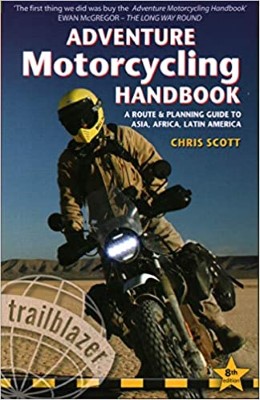Merzouga to Tafroute
In the evening we picked up a couple of

s with Milan at a hotel in Merzouga and had a nice time, entertaining the little daughter of a French couple with drums (and everything that made noise). For a moment Milan and me considered driving together through the Sahara pistes so that he'd be my backup car and I'd safe the 4x4. Luckily I rejected the option, as the pistes we took were nowhere near drivable in a regular road car. So I settled for the 4x4 option and Tarik arranged everything so that our driver, Zait, came later that morning in a fairly modern Toyota Land Cruiser and we could set off early enough.
A quick side note on travelling the desert pistes alone: Most of the Moroccan desert isn't too technical but mainly rocky. Yet a lot of surprises can happen on the way and the area is very remote, so help can be difficult to find. Also, navigating can be more difficult than one might think, if one isn't familiar with the area. My Satnav was obviously relying on the waypoints I entered, which were following routes MS6 and MS7 in Chris Scott's road book. Sometimes there is need to deviate from the route though, which is when regional knowledge is quite helpful. For this reason I would not recommend anyone to approach the desert alone. Bear in mind that every year tourists get lost or seriously harmed in the area, because they underestimate the challenge. Experienced desert riders will be fine though.
After getting fuel, filling up water and getting some bread and sardines, we approached the first leg of the pistes: Merzouga to Tafroute, crossig the (usually dry) river Rheris in between. That day could hardly be called desert riding, which was fair enough, as it wasn't desert yet. The route went through beautiful parts of the Jebel Sahro, pretty much along the Algerian border (don't get too close, it's mined!).
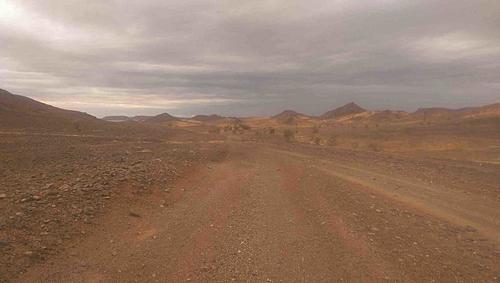
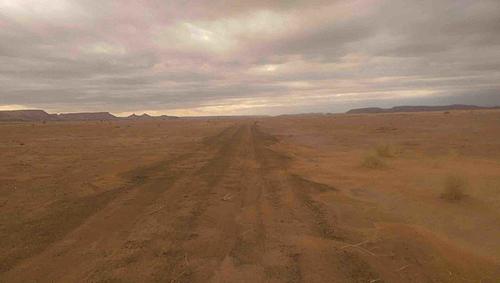 The piste before crossing Rheris
The piste before crossing Rheris
On our first day we were accompanied by some light rain, which turned some otherwise dusty stretches into the soapiest mud you can imagine. Especially Oued Rheris (Oued means river) was an absolute delight! Zait and Tarik had quite an advantage as they simply turned into crab-mode and went sideways most of the time - an option that's not available on two wheels. The challenge in crossing Rheris (which was just muddy but didn't carry any water) wasn't just the mud but also the fact that it was quite rutted. This meant that I was essentially sliding from rut to rut and ended up quite surprised that I made it through without going off. Normally, Rheris is known for being incredibly sandy by the way. And I can see that! We actually tried to avoid most of the mud at first by taking a detour slightly to the east, but the military police didn't like that and stopped us when we got too close to the border.
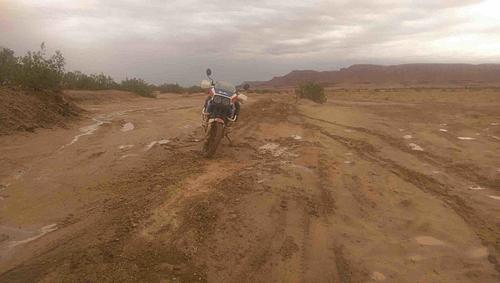
 I had to do a bit of road building to get further; right: Behind the mountains is Algeria
I had to do a bit of road building to get further; right: Behind the mountains is Algeria
Following Rheris was a stretch of relatively easy wet, but at parts also fairly deep sand and some steppe till we reached Tafroute. Almost. Just in front of it was a small river, that although looking harmless, wasn't passable. When I walked in a bit, it turned out that it was at least 0.5m deep and, more importantly, was very muddy. So chances were that we'd get stuck, or even worse, hit quicksand. So we ended up going through a palmerie till we found a safe crossing.
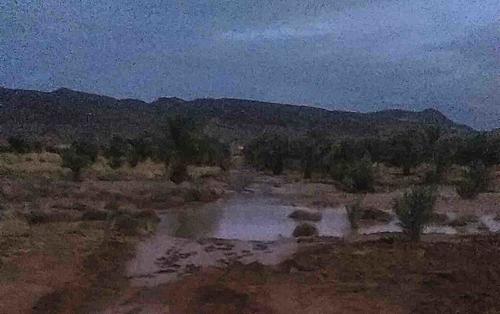
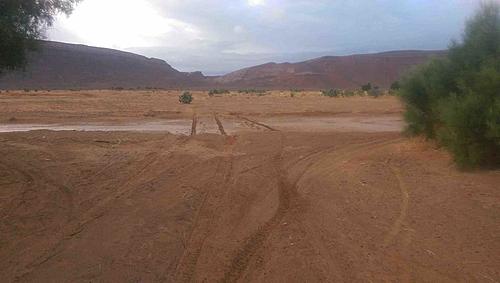 Left: Not safe to cross! If in doubt: walk it! Right: Yet more mud
Left: Not safe to cross! If in doubt: walk it! Right: Yet more mud
In Tafroute we booked ourselves into a nice auberge where we had some lovely Tajine and tea. It turned out that the area we were riding through had quite some archeological importance. Attached to the auberge they had an astonishing exhibition of prehistoric artifacts. Among those were handaxes that, for all I know, could be hundreds of thousand or even millions of years old - a famous example, the Olduvai Handaxe in the British Museum is 1.6 Million years old. Handaxes are astonishing artefacts as they are essentially prehistoric multitools. As such, they mark an important stage in human development where fairly complex tools were produced - indeed so complex that people would've had to communicate and teach the production of these tools.
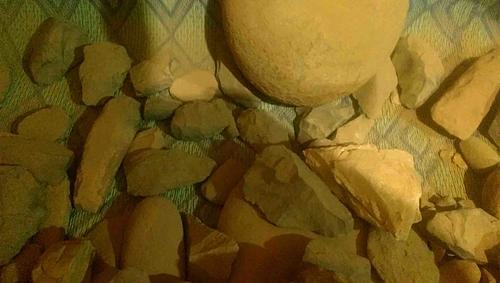 Handaxes exhibited in the auberge
Handaxes exhibited in the auberge
 Olduvai handaxe in the British Museum - 1.6 Million years old
Olduvai handaxe in the British Museum - 1.6 Million years old







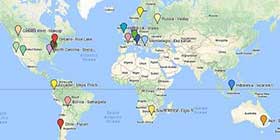











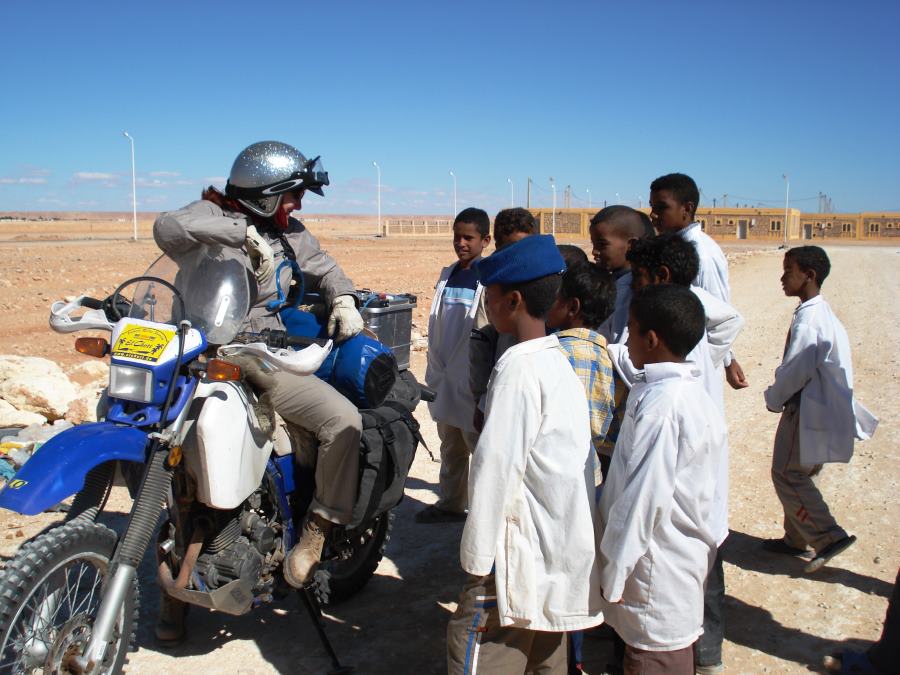

 3Likes
3Likes


 s with Milan at a hotel in Merzouga and had a nice time, entertaining the little daughter of a French couple with drums (and everything that made noise). For a moment Milan and me considered driving together through the Sahara pistes so that he'd be my backup car and I'd safe the 4x4. Luckily I rejected the option, as the pistes we took were nowhere near drivable in a regular road car. So I settled for the 4x4 option and Tarik arranged everything so that our driver, Zait, came later that morning in a fairly modern Toyota Land Cruiser and we could set off early enough.
s with Milan at a hotel in Merzouga and had a nice time, entertaining the little daughter of a French couple with drums (and everything that made noise). For a moment Milan and me considered driving together through the Sahara pistes so that he'd be my backup car and I'd safe the 4x4. Luckily I rejected the option, as the pistes we took were nowhere near drivable in a regular road car. So I settled for the 4x4 option and Tarik arranged everything so that our driver, Zait, came later that morning in a fairly modern Toyota Land Cruiser and we could set off early enough.
















 Threaded Mode
Threaded Mode



